A guide to using Woogles
We held our first virtual tournament on Woogles (read about it here), and we discovered that a lot of new players were a bit unfamiliar with Woogles, so we decided to write a guide to help you get started.
Creating a game
This is the main purpose of Woogles, so let's jump into it. On Woogles, you have 3 different ways to start a game:
- Play a computer.
- Match a friend.
- Create a game.
The one that you'll probably be using most of the time is "create a game". This creates a request for a game that anyone online can accept (within certain limits that'll be explained in a bit). When you click the "create a game" button, you'll see a pop-up that looks like this:
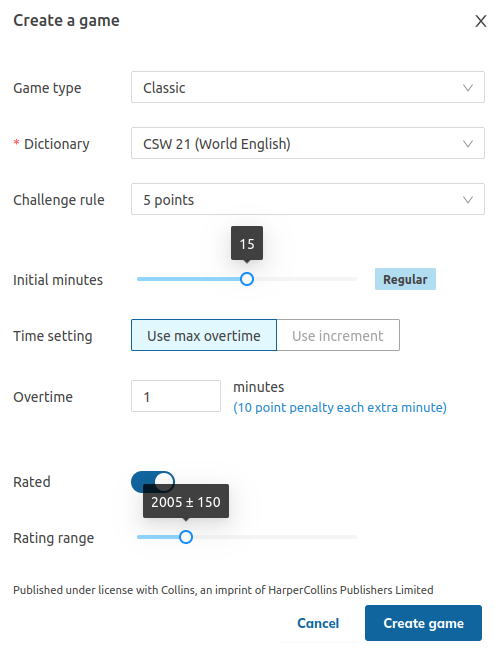
Let's go through these settings one by one:
-
Game type - almost all the time, this should be classic. The other option you have here is Wordsmog, a game that is similar to Clabbers.
-
Dictionary - this is the word list that you want to play with. International tournaments use CSW 21, while North American tournaments use NWL 20. Woogles also offers dictionaries for French, German and Norwegian, as well as the Common English Lexicon, a smaller dictionary containing only commonly-used words.
-
Challenge rule - this setting describes what should happen when a word is challenged. There are 6 options here. In all of them except void, a player whose invalid play was challenged loses their turn.
-
5 points - if the word is valid, the person who played it gets 5 points. This is the most common challenge rule in international tournaments.
-
10 points - a valid challenged word gains 10 points for the person who played.
-
Single challenge - there is no penalty for challenging a valid word, or reward to the other player.
-
Void challenge - all words are checked before they are played, so you can't play any invalid words. This is very rare in tournaments.
-
Double challenge - if the play is valid, the challenger loses their turn.
-
Triple challenge - if the play is valid, the challenger loses the game (no one actually uses this in serious games).
-
-
Initial minutes - the amount of time that each player starts the game with.
-
Time setting - this should be "use max overtime" or "use increment". If you've played chess before, you're probably familiar with the idea of increment. If you aren't, it basically means that you get a certain amount of time after every move you make.
However, increment is rare in Scrabble, and most games are instead played with overtime. This means that once your initial time runs out, you get a certain number of minutes more, with a 10 point penalty for each minute. Once this extra time also runs out, you lose the game.
-
Rated - whether this game should affect your Woogles rating, which is explained in more depth below.
-
Rating range - the range of ratings that people need to be in order to see your game request. For example, if you're rated 1600 and you choose the rating range as ± 200, only people between 1400 and 1800 will be able to see your request.
Once you've set your preferred game settings, click "Create game".
The next way to create a game is "match a friend". This lets you request a game from anyone who is online, and only the player you choose to send it to will be able to see it.
The final way is "play a computer". The main benefit of this is that computers are always available, and willing to play with any game settings, so you don't have to waste time looking for an opponent. There are 5 bots of varying difficulty:
- HastyBot - the strongest bot. It knows all the words in all dictionaries, and will always play the best move. Even the best players in the world only manage around 50% against this bot, so don't worry if you lose to it often.
- STEEBot - the next best bot. It knows all the words, but sometimes makes mistakes.
- BetterBot - this bot plays all the best moves that contain common words.
- BasicBot - this bot also knows only common words and makes a few mistakes.
- BeginnerBot - this bot sticks to lower-scoring plays or common words.
Playing games
Once you've created a game, and found an opponent, you'll be taken to the Woogles gameroom. This is a made up of a few important components that I'll explain individually below.
Firstly, the board.
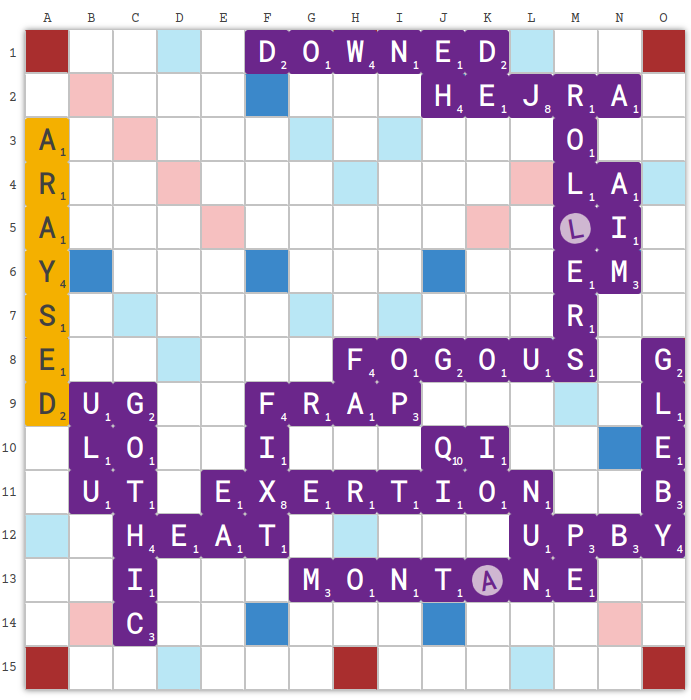
On Woogles,
- The word that was played last is shown in a different color (ARAYSED, in this case).
- Blanks are signified by a circle and slanted text (see the A in MONTaNE or the L in ROLlERS).
- The columns of the board are labeled A to O, and the rows are labeled 1 to 15. This is just to make it easier to keep track of where plays were made.
Below the board, you'll have your rack.

To the left of your tiles, you should see a down arrow, which you can use to recall any tiles that you've placed on the board. To the right, there's another button that you can use to randomly shuffle your rack.
Just below your rack, there are 4 buttons:

If you click "options", you'll see a dropdown menu with the following items:
-
Resign - this ends the game as a loss for you and affects your rating. You could use this when you're absolutely sure that you can't win the game, although this isn't recommended against humans, especially in tournaments.
If you need to leave in the middle of a game, please resign instead of simply letting your time run out. Timing out like this too often will get you suspended.
-
Nudge - if your opponent isn't playing and you think that they have left the game, you can nudge them. If they don't respond in 2 minutes, you'll automatically be awarded the win.
-
Cancel game - clicking this will request your opponent for a cancellation of the game, with no effect on ratings.
The others are simple - pass and exchange do the same as in ordinary Scrabble games, and "play" can be used to confirm a move you've typed out on the board (you can also use the Enter key for this).
Near the bottom right of this screen (this will be different on mobile), you can see each player's score and how much time they have remaining.

The person shown on top is the player who goes first. Their score is just below their name (430 for STEEBot in this case), and next to that is the time they have left.
If the background for a player's score is green, that means that it is their turn. If they are low on time, this will be yellow instead, and if they are overtime, it will be red.
To the right of the board, you'll also see a list of moves played in the game by both players.
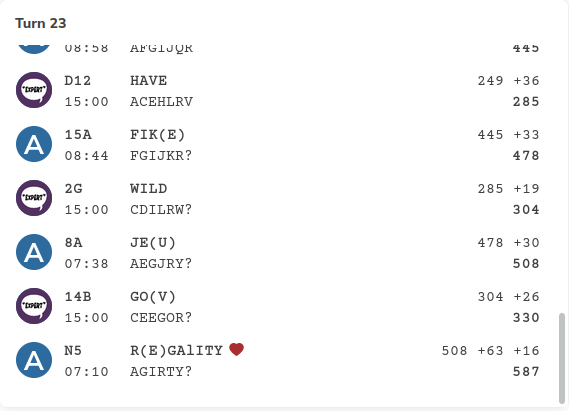
Each entry in the list shows
- The square the move was played
- The word played, with blanks in lowercase, like the L of REGAlITY. Letters in brackets, like the U of JE(U) were already present on the board when the move was made.
- The player's score before the move, the score for the move, and the score after the move.
- The rack the player had when making the move. While you're playing a game, only your tiles will be visible to you, but once the game finishes, you'll be able to see your opponents racks as well.
On Woogles, you can also view unseen tiles, or tiles that haven't been played yet.

You may notice that it says "8 tiles in bag" but actually shows 15. This is because there 7 tiles on your opponent's rack are also included there.
Finally, to the left of the board, you can see two other components, labeled "chat" and "notepad".

The first allows you to chat privately with your opponent. At the end of the game, if any invalid words were played, they will show up here.
The second is a place that you can use to note down your thoughts during the game. These are not visible to your opponent, Clicking the + icon will copy your current rack into the notepad.
After the game
When your game ends, below the board, you'll see a notification saying something like "[username] wins. Final score: 452 - 422." You'll also see 4 new buttons appear just below that.

The first is export, which allows you to save your game as a PNG, GIF or GCG (the format used by Quackle).
The next is examine, which lets you go through your game and see what you or your opponent may have missed. This is explained further in the watching games section.
Finally, you'll also see a "Rematch" button, which sends your opponent a request for another game with the same game settings.
Watching games
Watching games, especially those of high-rated players, is a good way to pick up some new words, and learn a bit more about Scrabble strategy too.
You can see a list of ongoing games, sorted by rating, in the "Watch" tab of the main page:

Each list item shows:
- The usernames and ratings of the players involved.
- The dictionary (you can filter this list by clicking the icon next to "words" in the header).
- The time control in use (+ indicates increment, / indicates overtime).
- The challenge rule and whether the game is rated.
Clicking on an entry in the list will take you to that game, and you'll see a layout like the one discussed above in the playing games section.
Here, the chat box is for observers to chat with each other, and players in the game won't be able to see messages sent here. Also, you'll be able to use the examine option while the game is still ongoing.
Examining games
Examining games lets you go through the moves of a game at your own pace, and see what the best moves were in each situation. You can navigate through the game using the controls just below the rack.
Woogles gives you built-in analysis for free, allowing you to see the move that the computer recommends. In place of the usual notepad, you'll be able to see something titled "analyzer".
Clicking the lightbulb icon will show you the best moves, and checking the "auto" option will do this automatically as you go through the game.
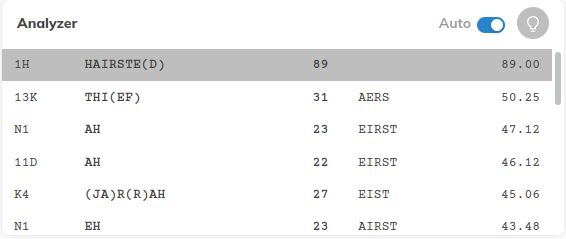
The move in grey is what was actually played in the game. The moves are ordered by equity, which is basically a measure of how good a move was, based on the score and rack leave.
You can examine your past games by visiting your profile (click your username in the navigation bar, then click "view profile" in the menu that appears) and clicking on the final score of the game you want to view.
Please note that examining or analysing your own games while they are in progress is cheating, and can get you banned from Woogles.
Your profile
On Woogles, all users have a profile page. This lets you see their ratings (discussed further below), recent games and a short about section (if they've written one).
The link to a Woogles profile page takes the form woogles.io/profile/[username]. For example, mine is woogles.io/profile/thams.
Ratings
At the top of your profile, you'll see a section called "ratings". Here's what mine looks like:
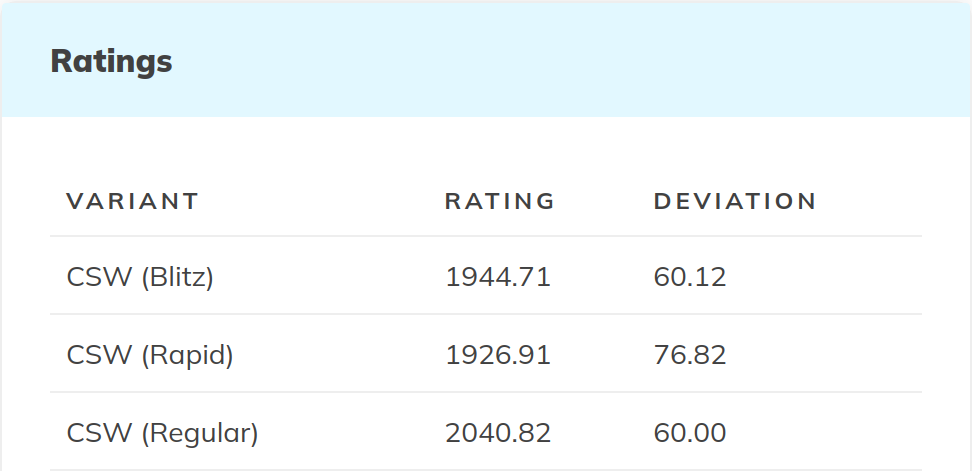
Woogles has different ratings for each dictionary and time control. Ultrablitz games are 2 minutes or less (including overtime), blitz games are 6 minutes or less, rapid games are 14 minutes or less, and regular is everything else.
Every time you play a rated game, Woogles will update your rating based on the outcome of the game. If you win, you gain rating, and if you lose, you lose rating.
The rating of your opponent also affects the change - if you're have a higher rating than them, then you'll lose more rating from a loss than you will gain from a win. If you're lower rated, this is reversed - you'll gain more for a win than you'll lose for a loss.
Finally, the Woogles rating system also incorporates the idea of rating deviation. If you haven't been active in a time control for a while, then your rating deviation will be higher. The lowest possible rating deviation is 60, and the highest is 350.
The higher the rating deviation, the more wildly your rating will fluctuate.
Game history
Below the rating section, you'll see a list of games that a user recently played. This will show the outcome, opponent, final score and some other useful information. To examine a game, just click the final score of the game you want to look at.
Interacting with other players
On Woogles, you can chat with other players outside of the game chat. To do so,
- Switch to the "chat" tab next to "players"
- Click "all chats"
- Click "+ start new chat" and enter the username of the person you want to talk to
- Now, send them a message!
You can go back to a chat at any time, by clicking "all chats" and then the username of the person you were chatting with.
You can request a game from a specific player using the "match a friend" button. If you want to know if someone is online, you can switch to the "Players" tab and type their name in the "search players" field.
To make this easier, you can add people to your friends list. This way, you'll be able to know when they're online and whether they're playing a game or if they're watching one.

If you want to prevent someone from sending you messages or seeing messages you send, you can block them by clicking their username and selecting "block".